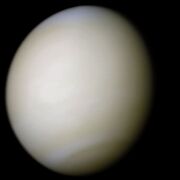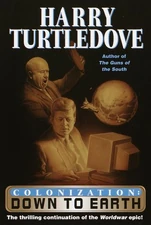
This article is about the planet Venus. For the mythological goddess, see Aphrodite.
Venus is the second-closest planet to the Sun, orbiting it every 224.7 Earth days. It is sometimes called Earth's "sister planet", for the two are similar in size, gravity, and bulk composition. Venus is named after the Roman goddess of love and beauty.
Prior to the mid-20th century, many scientists believed Venus to be suitable for life, and numerous works of speculative fiction were based on that premise.
Venus in "But It Does Move"[]
When explaining the Copernican system to Cardinal Sigismondo Gioioso, Galileo Galilei used the orbit of Venus as an example, explaining that no one had ever seen Venus "full", and never would, because it is full only when it lies beyond the Sun.
Gioioso noted that only those with spyglasses would see this. Galileo agreed that it would be invisible to the naked eye.
Venus in Crosstime Traffic[]
In several alternates, Earth was on the verge of manned trips to Venus.
Venus in Worldwar[]
When humans first explored space in the mid 20th century, they found Venus to be world with too much atmosphere, the greenhouse effect run wild, and no chance for life. It did not at all resemble the romantic version dreamed up by pre-alien contact science fiction writers such as Stanley Weinbaum.[1]
The Race called Venus "Tosev 2".
References[]
- ↑ Homeward Bound, p. 147.
| |||||
| |||||
| |||||||||||||||||||||||||







